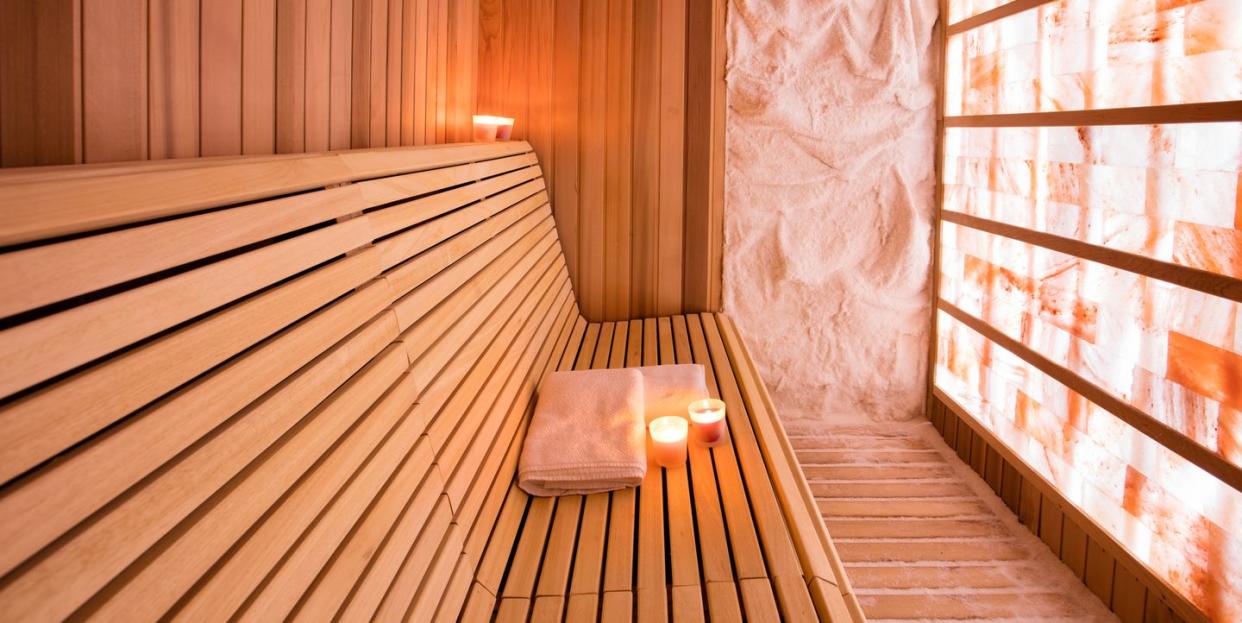What Is Halotherapy? And Why You Should Add a Salt Cave Component to Your Wellness Routine

From freezing chambers to infrared saunas and more, the experience of sitting in unique environments for the sake of wellness is a common pursuit. Halotherapy, or salt therapy, (‘Halo’ is the Greek word for salt) reproduces the naturally occurring environments of salt mines found in countries like Poland and Russia. And like other wellness practices, halotherapy dates way back. In fact, it was first officially recognized as a therapy by Polish physician Dr. Felikz Boczowski in 1843, who’d taken note of the absence of respiratory problems in salt mine workers. Here we asks the experts why sitting in a salt cave may very well be a wonderful treatment for modern ailments.
What are salt caves—and what is halotherapy?
Halotherapy is more familiar than it might initially seem. Case in point: anyone who’s ever gargled with salt water to quell a sore throat, or even disinfected a wound with salt water has practiced “wet halotherapy.” Dry halotherapy can take a number of forms— “In some respects, a day at the beach is a Halotherapy session,” explains Alex Eingorn, a chiropractor and co-manager of Breathe Salt Room in Manhattan.
As far as manmade salt rooms, or salt caves go, there are typically two main kinds. Some are exactly as they sound, rooms in which the walls are made of Himalayan salt bricks and the floors covered in salt. The second kind uses a halogenerator, a machine which blows tiny particles of pharmaceutical grade salt into the air. These caves were created to mimic the micro-climate of salt mines and allow visitors to benefit from the inhalation of salt-infused air, and are generally considered more beneficial than those without halogenerators.
What should I expect if I go in a salt cave?
One good thing about halotherapy is how low-lift a commitment it is. Once you’re sitting in a salt cave, the experience is not so different from sitting outside of one. While ideally one might meditate, you can read a book, or even catch up on emails from a salt cave too. (There are usually some lounge chairs). While you can go in a salt cave in your everyday clothes, comfy, non-precious athleisure is ideal, and some spaces provide robes and shoe covers to help protect clothes from salt particles settling on them.
A post shared by Purify Wellness Center (@purifywellnesscenter) on Jan 11, 2020 at 7:21am PST
How does it work and what conditions and ailments does salt room therapy treat?
Quite simply: the entire practice boils down to breathing dry, salty air.
“It is commonly believed that the Himalayan salt will release negative ions (electrons) into the air,” Eingorn says, explaining that “inflamed tissue is usually acidic, that is electron deficient, and thus, more electrons available will help the inflamed cells repair. Inasmuch as it is a plausible theory, the scientific evidence is lacking to support this belief.”
Though advocates for halotherapy claim that the practice can help with countless ailments, respiratory conditions, like sinus infections, allergies, and asthma, show the most promise. “When pure pharmaceutical grade salt (NaCl) is ground into microscopic particles and vaporized into a sealed environment, such as a salt room, or a salt cave, it can be inhaled freely, and will interact with the epithelial cells that line the nasal, sinus, and air passageways,” Eingorn says. “In the right concentration,” he explains, this “has a therapeutic effect on the respiratory mucosa. Due to the hydrophilic nature of salt, upon contact with epithelial mucous cells, it will tend to reduce swelling associated with inflamed mucosa. Since salt is a natural antiseptic and a disinfectant, halotherapy is very effective in treating, and preventing many respiratory illnesses.”
Fans of the practice commonly report improved sleep, and “There is some evidence that it is helpful in treating some skin disorders,” including eczema, psoriasis, and rosacea, Eingorn says, noting however, that one would have to have the skin exposed during the session.
A post shared by Montauk Salt Cave (@montauksaltcave) on Feb 4, 2020 at 6:26am PST
How should halotherapy be utilized in order to see results?
While of course, consistent visits to a salt cave can lead to greater results, the effects of a session can be felt “almost immediately,” Eingorn, notes that “most, if not all, report improvement in breathing and better sleep following the session.” The effects can be long lasting, too, he says, explaining that, while effects vary from person to person, “often one session will suffice for weeks or months.”
A post shared by Montauk Salt Cave (@montauksaltcave) on Sep 1, 2019 at 11:09am PDT
Should you try halotherapy?
Though consulting a medical professional should always be the first step before trying any new alternative therapy, halotherapy is a very safe practice with few contraindications. According to Eingorn, only “patients with severe inflammatory disorders, usually requiring medical monitoring, and those with claustrophobia, should not use the salt rooms.”
Halotherapy is considered a valid supplement to traditional medicine. “The practice has been around for centuries, we use it often with patients when we ask them to use saline rinses for their sinuses and gargles for their sore throats,” explains Dr. Mukesh Prasad, Associate Professor of Clinical Otolaryngology at Weill Cornell Medical College, Cornell University. “The use of salt rooms is more recent but makes sense with the number of patients who come home feeling better after spending time near the ocean or on a beach, even for a short time,” he explains, adding that “while more formal research to identify the true benefits would be welcome, I have seen the success experienced by many patients who had tried the salt rooms as we treat them for sinus infections."
You Might Also Like

